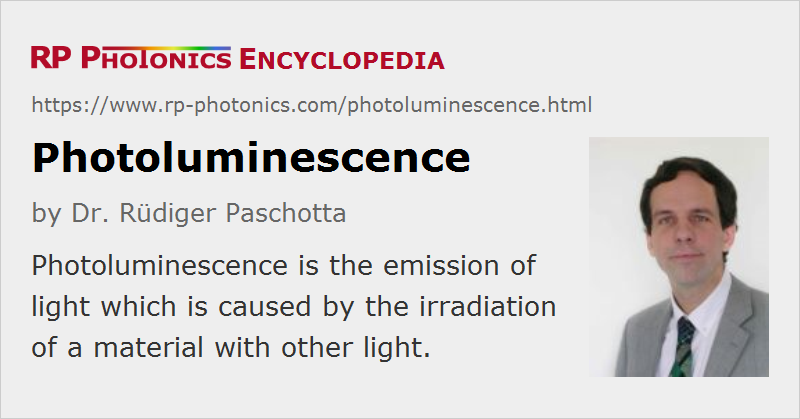Photoluminescence
Acronym: PL
Definition: emission of light which is caused by the irradiation of a material with other light
More general term: luminescence
German: Photolumineszenz
Category: physical foundations
How to cite the article; suggest additional literature
Author: Dr. Rüdiger Paschotta
Photoluminescence is the emission of light which is caused by the irradiation of a substance with other light. The term embraces both fluorescence and phosphorescence, which differ in the time after irradiation over which the luminescence occurs. It is used in many photonic devices, for example in light emitting diodes and on phosphor screens.
Photoluminescence is often used in the context of semiconductor devices (e.g. semiconductor lasers and solar cells), even when the luminescent emission is not the actual purpose of the device. Here, photoluminescence is excited by illumination of the device with light which has a photon energy above the band gap energy. The photoluminescence then occurs for wavelengths around the band gap wavelength. The optical spectrum of the photoluminescence (PL spectrum) and also the dependence of its intensity on the irradiation intensity and device temperature can deliver important information for device characterization. In particular, PL spectra and their intensity dependencies can allow one
- to determine the band gap energy and/or the wavelength of maximum gain
- to determine the composition of ternary or quaternary layers
- to determine impurity levels (which can e.g. lead to the emission of light with longer wavelengths than otherwise possible)
- to investigate recombination mechanisms
Photoluminescence mappers (PL mappers) can spatially resolve the photoluminescence, e.g. from epitaxially grown wafers. PL maps can reveal, e.g., a radial dependency of layer thickness or material composition.
Questions and Comments from Users
Here you can submit questions and comments. As far as they get accepted by the author, they will appear above this paragraph together with the author’s answer. The author will decide on acceptance based on certain criteria. Essentially, the issue must be of sufficiently broad interest.
Please do not enter personal data here; we would otherwise delete it soon. (See also our privacy declaration.) If you wish to receive personal feedback or consultancy from the author, please contact him e.g. via e-mail.
By submitting the information, you give your consent to the potential publication of your inputs on our website according to our rules. (If you later retract your consent, we will delete those inputs.) As your inputs are first reviewed by the author, they may be published with some delay.
See also: fluorescence
and other articles in the category physical foundations
 |



If you like this page, please share the link with your friends and colleagues, e.g. via social media:
These sharing buttons are implemented in a privacy-friendly way!